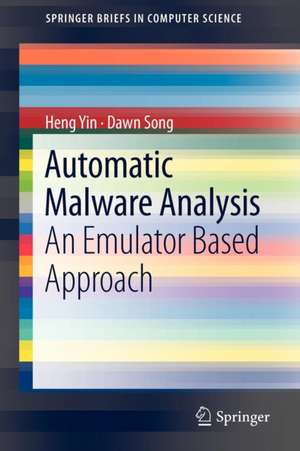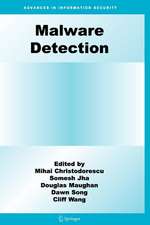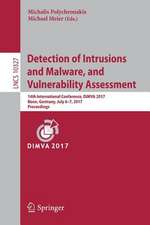Automatic Malware Analysis: An Emulator Based Approach: SpringerBriefs in Computer Science
Autor Heng Yin, Dawn Songen Limba Engleză Paperback – 14 sep 2012
Automatic Malware Analysis presents a virtualized malware analysis framework that addresses common challenges in malware analysis. In regards to this new analysis framework, a series of analysis techniques for automatic malware analysis is developed. These techniques capture intrinsic characteristics of malware, and are well suited for dealing with new malware samples and attack mechanisms.
Din seria SpringerBriefs in Computer Science
-
 Preț: 475.83 lei
Preț: 475.83 lei - 20%
 Preț: 166.97 lei
Preț: 166.97 lei - 20%
 Preț: 325.63 lei
Preț: 325.63 lei - 20%
 Preț: 349.15 lei
Preț: 349.15 lei - 20%
 Preț: 302.49 lei
Preț: 302.49 lei -
 Preț: 381.81 lei
Preț: 381.81 lei -
 Preț: 446.47 lei
Preț: 446.47 lei - 20%
 Preț: 296.17 lei
Preț: 296.17 lei - 20%
 Preț: 335.66 lei
Preț: 335.66 lei - 20%
 Preț: 463.83 lei
Preț: 463.83 lei - 20%
 Preț: 323.00 lei
Preț: 323.00 lei - 20%
 Preț: 322.35 lei
Preț: 322.35 lei - 20%
 Preț: 321.85 lei
Preț: 321.85 lei - 20%
 Preț: 232.68 lei
Preț: 232.68 lei -
 Preț: 375.45 lei
Preț: 375.45 lei - 20%
 Preț: 323.00 lei
Preț: 323.00 lei - 20%
 Preț: 322.81 lei
Preț: 322.81 lei - 20%
 Preț: 324.17 lei
Preț: 324.17 lei - 20%
 Preț: 323.00 lei
Preț: 323.00 lei - 20%
 Preț: 322.17 lei
Preț: 322.17 lei - 20%
 Preț: 322.50 lei
Preț: 322.50 lei - 20%
 Preț: 323.34 lei
Preț: 323.34 lei - 20%
 Preț: 324.17 lei
Preț: 324.17 lei - 20%
 Preț: 323.46 lei
Preț: 323.46 lei - 20%
 Preț: 322.17 lei
Preț: 322.17 lei - 20%
 Preț: 322.02 lei
Preț: 322.02 lei -
 Preț: 341.50 lei
Preț: 341.50 lei - 20%
 Preț: 324.49 lei
Preț: 324.49 lei -
 Preț: 344.47 lei
Preț: 344.47 lei -
 Preț: 376.80 lei
Preț: 376.80 lei -
 Preț: 377.18 lei
Preț: 377.18 lei - 20%
 Preț: 324.17 lei
Preț: 324.17 lei - 20%
 Preț: 352.26 lei
Preț: 352.26 lei - 20%
 Preț: 321.32 lei
Preț: 321.32 lei - 20%
 Preț: 322.17 lei
Preț: 322.17 lei - 20%
 Preț: 324.17 lei
Preț: 324.17 lei - 20%
 Preț: 322.02 lei
Preț: 322.02 lei -
 Preț: 374.46 lei
Preț: 374.46 lei - 20%
 Preț: 320.21 lei
Preț: 320.21 lei - 20%
 Preț: 323.34 lei
Preț: 323.34 lei - 20%
 Preț: 324.17 lei
Preț: 324.17 lei - 20%
 Preț: 231.84 lei
Preț: 231.84 lei - 20%
 Preț: 294.97 lei
Preț: 294.97 lei - 20%
 Preț: 322.50 lei
Preț: 322.50 lei - 20%
 Preț: 323.46 lei
Preț: 323.46 lei -
 Preț: 374.08 lei
Preț: 374.08 lei -
 Preț: 408.23 lei
Preț: 408.23 lei - 20%
 Preț: 321.52 lei
Preț: 321.52 lei - 20%
 Preț: 323.34 lei
Preț: 323.34 lei - 20%
 Preț: 323.00 lei
Preț: 323.00 lei
Preț: 322.02 lei
Preț vechi: 402.53 lei
-20% Nou
Puncte Express: 483
Preț estimativ în valută:
61.62€ • 64.57$ • 50.94£
61.62€ • 64.57$ • 50.94£
Carte tipărită la comandă
Livrare economică 12-26 aprilie
Preluare comenzi: 021 569.72.76
Specificații
ISBN-13: 9781461455226
ISBN-10: 1461455227
Pagini: 84
Ilustrații: IX, 73 p. 15 illus.
Dimensiuni: 155 x 235 x 13 mm
Greutate: 0.13 kg
Ediția:2013
Editura: Springer
Colecția Springer
Seria SpringerBriefs in Computer Science
Locul publicării:New York, NY, United States
ISBN-10: 1461455227
Pagini: 84
Ilustrații: IX, 73 p. 15 illus.
Dimensiuni: 155 x 235 x 13 mm
Greutate: 0.13 kg
Ediția:2013
Editura: Springer
Colecția Springer
Seria SpringerBriefs in Computer Science
Locul publicării:New York, NY, United States
Public țintă
ResearchCuprins
Introduction.- Dynamic Binary Analysis Platform.- Hidden Code Extraction.- Privacy-breaching Behavior Analysis.- Hooking Behavior Analysis.- Analysis of Trigger Conditions and Hidden Behaviors.- Concluding Remarks.
Recenzii
From the reviews:
“The authors present their architecture for dynamic binary analysis of malware. … The authors do this quite well. Each chapter ends with a chapter summary and extensive references. … the book presents a good concise explanation of the proposed architecture for automated detection of malware. It makes a useful little brief for quickly coming to grips with the basics of how malware works.” (David B. Henderson, Computing Reviews, May, 2013)
“The authors present their architecture for dynamic binary analysis of malware. … The authors do this quite well. Each chapter ends with a chapter summary and extensive references. … the book presents a good concise explanation of the proposed architecture for automated detection of malware. It makes a useful little brief for quickly coming to grips with the basics of how malware works.” (David B. Henderson, Computing Reviews, May, 2013)


























